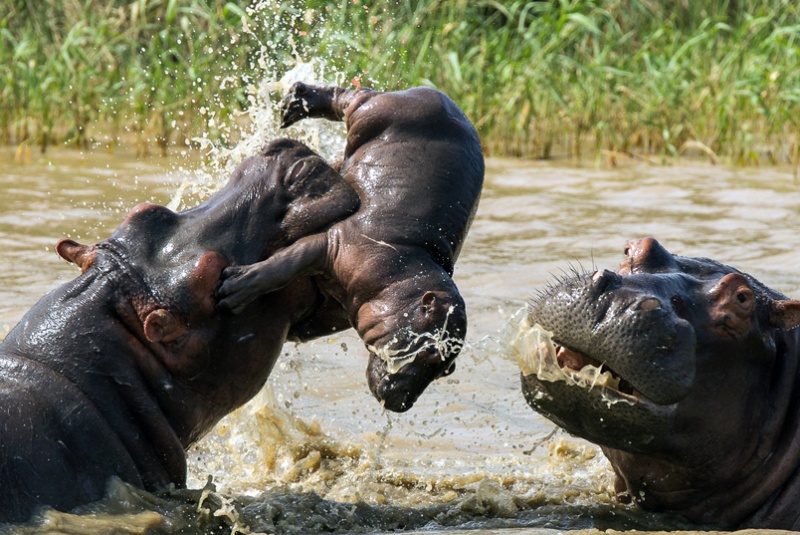The animal kingdom is replete with incredible creatures that have adapted in unique ways to thrive in their environments. Among them, the hippopotamus stands out not just for its size but also for its peculiar habits and contributions to the ecosystem. Imagine if you had the ability to slumber blissfully in a tranquil lake with no fear of drowning. This scenario isn't a fantasy for the mighty hippo, an animal that has mastered life both in and out of water with fascinating adaptability.

Hippos are able to rest underwater, surfacing only to breathe without fully awakening. This ability is an astounding evolutionary trait that sets them apart in the animal world. Hippos typically spend around 16 hours each day submerged in water, which is their preferred and safe haven. This extended time in the aquatic environment is vital for the hippo due to the sensitivity of its skin, which is susceptible to sunburn and dehydration. To cope with these vulnerabilities, hippos have developed a lifestyle deeply intertwined with water.
They can hold their breath for approximately five minutes. Even while asleep, they automatically bob their heads to the surface to breathe, then sink back into the depths, all without disturbing their slumber. This automatic response is critical for their survival, as it ensures they can rest without the risk of drowning.
The extensive amount of time hippos spend in water isn't just a personal preference but also a necessity. Their skin secretes a natural sunscreen, often referred to as "blood sweat," which protects them from the harsh African sun. This reddish fluid is crucial in preventing sunburn and bacterial infection, allowing hippos to spend their days in water without harm.
While it may be common to associate the appearance of hippos with pigs or even rhinoceroses due to their massive size and stout form, genetics tell us a different story. Research into hippopotamus DNA reveals a closer genetic link to cetaceans—whales, dolphins, and porpoises—than any land mammal. This connection is surprising but evident when considering their semi-aquatic nature and evolutionary history.
Indeed, it's believed that around 55 million years ago, the common ancestors of hippos and whales shared the ocean as their home. This lineage is hinted at in whales today by the presence of vestigial structures within their bodies, like the "ankle" bone, a remnant from their terrestrial past that serves no purpose in their current form. The whale's evolutionary journey took them fully into the marine environment, whereas the hippo's ancestors became the semi-aquatic giants we know today.
Beyond their intriguing evolutionary backstory, hippos play a critical role in their habitats. Referred to by scientists as "ecosystem engineers," they contribute significantly to the health and vitality of their environments. Their large size and movements create paths in both waterways and landscapes, which are more than mere tracks; these are channels that enable water to flow during the wet seasons, bringing life to otherwise arid regions.
The channels carved by hippos help distribute water across the African savannahs, facilitating the growth of plant life and benefiting the entire ecosystem. Birds, insects, and other wildlife find new habitats thanks to the paths created by these enormous animals. These channels also aid in preventing stagnation of water bodies, promoting a healthy aquatic ecosystem.
Despite their bulk and seemingly ungainly legs, hippos are deceptively agile and can move with surprising speed. On land, they can reach speeds of up to 18 miles per hour, an impressive feat for such heavy creatures. This agility is essential for their survival, enabling them to quickly traverse the land to reach food sources or escape threats. Their speed is something to behold and a reminder to those on safari that despite their peaceful demeanor in water, hippos are formidable on land as well.
Considering these remarkable qualities and contributions, it becomes clear that the hippopotamus is not just a fascinating subject of study but also a vital component of its ecosystem. These semi-aquatic mammals influence the distribution and abundance of water, shape the landscape, and support a diversity of life forms, all while navigating their existence between land and water with a grace that belies their massive stature.
Their daily activities—ranging from leisurely soaks in the waters to their thunderous sprints on the savannah—paint a picture of an animal perfectly tuned to its environment. As ecosystem engineers, hippos don't just survive; they mold the very world around them to ensure that life, not just their own, continues to flourish.
The hippopotamus, with its evolutionary quirks and critical ecological role, offers a vivid example of how a species can become an integral part of the biological tapestry of our planet. Their unique adaptations allow them to serve as a keystone species, one that supports the very foundation of the ecosystem they inhabit. From their relationship with ancient whales to their surprising agility and their indispensable role in shaping the environment, hippos continue to captivate and remind us of the intricate connections that bind all life on Earth. Their existence is not just a curiosity but a profound statement on the resilience and interdependence of life.




